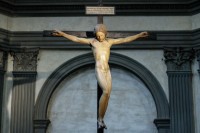 A painted wooden crucifix by Michelangelo Buonarrotti has returned to its original home, the Basilica of Santa Maria del Santo Spirito in Florence, after a fresh restoration and a year on the road. Carved by the artist when he was 18 or so, it’s one of his earliest extant works. Not the earliest, though, because Michelangelo’s artistic gifts were evident from a very young age.
A painted wooden crucifix by Michelangelo Buonarrotti has returned to its original home, the Basilica of Santa Maria del Santo Spirito in Florence, after a fresh restoration and a year on the road. Carved by the artist when he was 18 or so, it’s one of his earliest extant works. Not the earliest, though, because Michelangelo’s artistic gifts were evident from a very young age.
Michelangelo was apprenticed to Domenico Ghirlandaio, then at the peak of his popularity and productivity, in 1488. It’s a testament to Michelangelo’s indisputably immense talent (and his irascible father’s insistence) that even though he was just 13 years old, his apprenticeship contract guaranteed him a salary, six florins for the first year, eight for the second, 10 for the third. This kind of deal was very much against custom for such a young, unproven apprentice. Michelangelo was special, though, and Ghirlandaio knew it.
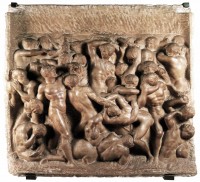 The lad didn’t end up spending three years in Ghirlandaio’s workshop as per contract anyway. In 1489, Lorenzo de’ Medici asked Ghirlandaio to send his two best students to an academy for sculptors and painters Lorenzo had founded in his palace gardens where he also maintained an extensive collection of Roman antiquities. This was a seminal period for the teenaged Michelangelo. Lorenzo took a personal interest in him, inviting him to live in the palace and exposing him to the greatest Humanist thinkers, artists and poets of the era assembled at the Medici court. He carved his first two sculptures at Lorenzo’s academy, the marble bas reliefs the Madonna of the Stairs and the Battle of the Centaurs, the latter showcasing how strongly influenced Michelangelo was by classical design already. For the rest of his life he would consider himself first and foremost a sculptor no matter how famous and in demand he became for his frescoes and paintings.
The lad didn’t end up spending three years in Ghirlandaio’s workshop as per contract anyway. In 1489, Lorenzo de’ Medici asked Ghirlandaio to send his two best students to an academy for sculptors and painters Lorenzo had founded in his palace gardens where he also maintained an extensive collection of Roman antiquities. This was a seminal period for the teenaged Michelangelo. Lorenzo took a personal interest in him, inviting him to live in the palace and exposing him to the greatest Humanist thinkers, artists and poets of the era assembled at the Medici court. He carved his first two sculptures at Lorenzo’s academy, the marble bas reliefs the Madonna of the Stairs and the Battle of the Centaurs, the latter showcasing how strongly influenced Michelangelo was by classical design already. For the rest of his life he would consider himself first and foremost a sculptor no matter how famous and in demand he became for his frescoes and paintings.
The death of Lorenzo de’ Medici on April 8th, 1492, put an abrupt end to Michelangelo’s formative idyll. He moved back in with his father, but he continued to study on his own. The Augustinian prior of the convent of Santo Spirito allowed the artist rooms to live with them from the spring of 1493 until the fall of 1494 so he could do anatomical studies of cadavers in the associated hospital of Santo Spirito. Lorenzo’s son Piero de’ Medici, called the Unfortunate, who was a big fan of Michelangelo, gave him permission to dissect and examine the hospital’s corpses, a rare opportunity for a young artist, and one he did not squander.
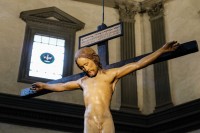 He carved the polychrome wooden crucifix to thank the prior for giving him lodgings and an invaluable understanding of the human body. When medical professionals examined the carving a few years ago, they determined it was an accurate and realistic reproduction of a dead youth about 14 years old. It seems Michelangelo, then just a few years older than the deceased boy who served as his unwitting model, gave Santo Spirito the very fruits of the anatomical studies it had made possible.
He carved the polychrome wooden crucifix to thank the prior for giving him lodgings and an invaluable understanding of the human body. When medical professionals examined the carving a few years ago, they determined it was an accurate and realistic reproduction of a dead youth about 14 years old. It seems Michelangelo, then just a few years older than the deceased boy who served as his unwitting model, gave Santo Spirito the very fruits of the anatomical studies it had made possible.
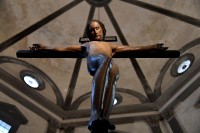 The sculpture hung above the high altar of Santo Spirito until the early 17th century when the altar was replaced with a more elaborate one. Michelangelo’s simple design was no longer deemed appropriate for the new setting and it was moved. After the French occupation in the late 18th century and the dissolution of the monasteries, the crucifix was considered lost. In fact, it never left Santo Spirito. It was rediscovered in 1962 by German art historian Margrit Lisner during her cataloguing of Tuscan crucifixes. It was hanging in a corridor at the convent and had been so thickly overpainted that not just its color was altered, but its form as well. With the original features dreadfully obscured in this condition, Lisner’s identification of it as the Michelangelo work was very much in doubt.
The sculpture hung above the high altar of Santo Spirito until the early 17th century when the altar was replaced with a more elaborate one. Michelangelo’s simple design was no longer deemed appropriate for the new setting and it was moved. After the French occupation in the late 18th century and the dissolution of the monasteries, the crucifix was considered lost. In fact, it never left Santo Spirito. It was rediscovered in 1962 by German art historian Margrit Lisner during her cataloguing of Tuscan crucifixes. It was hanging in a corridor at the convent and had been so thickly overpainted that not just its color was altered, but its form as well. With the original features dreadfully obscured in this condition, Lisner’s identification of it as the Michelangelo work was very much in doubt.
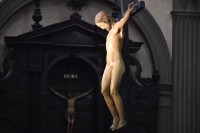 Nonetheless, it was cleaned and restored and put on display in the Casa Buonarrotti Museum, where it remained until December 2000 when it was returned to the basilica of Santo Spirito. While still not universally accepted, the attribution question was largely settled the next year when Umberto Baldini, director of the cultural division of Italy’s National Research Council, declared the carving the work of Michelangelo after a thorough artistic and forensic examination.
Nonetheless, it was cleaned and restored and put on display in the Casa Buonarrotti Museum, where it remained until December 2000 when it was returned to the basilica of Santo Spirito. While still not universally accepted, the attribution question was largely settled the next year when Umberto Baldini, director of the cultural division of Italy’s National Research Council, declared the carving the work of Michelangelo after a thorough artistic and forensic examination.
Now it has returned to its original stomping grounds, but in a new location. When the church reinstalled it in 2000, the crucifix was affixed to a side wall and could only be seen from the front. Today it hangs above the church’s old sacristy so people can walk beneath and around it and can view it from all sides.